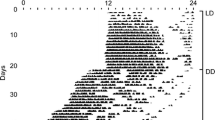Abstract
Circadian changes in behavioral responses to haloperidol were evaluated in rats under normal and altered lighting cycles. There was a 5.5-fold change in ED50 between the maximum (4 PM) and minimum (4 AM) cataleptic response to the drug under normal lighting (lights on 7 AM-7 PM). The rhythm was present whether the same rats were tested repeatedly, or fresh rats were used at each time to avoid drug effects which persist for at least several days. Under normal lighting, the maximum cataleptic effect of haloperidol corresponded closely to the light-phase minimum of spontaneous motor activity in untreated rats. Measures of sedation (ptosis and motor inhibition) induced by haloperidol yielded small circadian rhythms under normal lighting and were highly dependent on the baseline level of arousal. A month of constant light or dark, or reversed dark-light cycles had small effects on the sedative actions of haloperidol, although inhibition of locomotion tended to phase-shift with general arousal; these changes did not alter the catalepsy rhythm. While the circadian rhythm of spontaneous activity underwent a complete reversal within 1 month (t 1/2=17 days) of reversed lighting cycles, the catalepsy rhythm changed very gradually (t 1/2=82 days) and required nearly 6 months for complete reversal. Thus, catalepsy is a robust endogenously regulated circadian response that is only slowly influenced by altered lighting conditions which dissociate this rhythm of neuroleptic response from that of spontaneous general arousal. Endogenous neurobiologic and pharmacokinetic factors may contribute to circadian changes in neuroleptic responses.
Similar content being viewed by others
References
Baldessarini RJ, Campbell A, Madsen J, Herschel M, Finklestein S, Smith JM, Majocha R, Arana G (1981) Chronopsychopharmacology. Psychopharmacol Bull 17:112–113
Baldessarini RJ, Davis JM (1980) What is the best maintenance dose of neuroleptics in schizophrenia? Psychiatry Res 3:115–122
Campbell A, Baldessarini RJ (1981a) Effects of maturation and aging on behavioral responses to haloperidol in the rat. Psychopharmacology 73:219–222
Campbell A, Baldessarini RJ (1981b) Tolerance to behavioral effects of prolonged administration of haloperidol. Life Sci 29:1341–1346
Campbell A, Herschel M, Cohen BM, Baldessarini RJ (1980a) Tissue levels of haloperidol by redioreceptor assay and behavioral effects of haloperidol in the rat. Life Sci 27:633–640
Campbell A, Herschel M, Madsen JR, Baldessarini RJ (1980b) Diurnal changes in effects of haloperidol in rat. Soc Neurosci Abstr 6:707
Cohen BM, Herschel M, Miller E, Mayberg H, Baldessarini RJ (1980) Radioreceptor assay of haloperidol in the rat. Neuropharmacology 19:663–668
DeLean A, Munson PJ, Rodbard D (1978) Simultaneous analysis of families of sigmoidal curves: Application to bioassay, radioligand assay, and physiological dose-response curves. Am J Physiol 235:97–102
Evans HL, Ghiselli WB, Patton RA (1973) Diurnal rhythm in behavioral effects of methamphetamine, p-chloromethamphetamine and scopolamine. J Pharmacol Exp Ther 186:10–17
Jori A, DiSalle E, Santini V (1971) Daily hythmic variation and liver drug metabolism in rats. Biochem Pharmacol 20:2965–2969
Lemmer B, Berger T (1978) Diurnal rhythm in the central dopamine turnover in the rat. Arch Pharmacol Toxicol (Copenh) 303:257–261
Moore-Ede MC (1973) circadian rhythm of drug effectiveness and toxicity. Clin Pharmacol Ther 14:925–935
Naber D, Wirz-Justice A, Kafka MS, Wehr TA (1980) Dopamine receptor binding in rat striatum: Ultradian rhythm and its modification by chronic imipramine. Psychopharmacology 68:1–5
Nagayama H, Takagi A, Tateishi T, Takahashi R (1977) Circadian susceptibility rhythm to neuroleptics: Tetrabenazine. Psychopharmacology 55:61–66
Nagayama H, Takagi A, Nakamura E, Yoshida H, Takahashi R (1978a) Circadian susceptibility rhythm to apomorphine in the brain. Commun Psychopharmacol 2:301–310
Nagayama H, Takagi A, Sakurai Y, Nishiwaki K, Takahashi R (1978b) Chronopharmacological study of neuroleptics. II. Circadian susceptibility rhythm to chlorpromazine. Psychopharmacology 58:49–53
Nagayama H, Takagi A, Sakurai Y, Yoshimoto S, Nishiwaki K, Takahashi R (1978) Chronopharmacological study of neuroleptics. III. Circadian rhythm of brain susceptibility to haloperidol. Psychopharmacology 63:131–135
Niemegeers CJE (1974) Pre-clinical neuropsychopharmacology of neuroleptics: Prediction of side effects. In: Fielding S, Lal H (eds) Industrial Pharmacology, Vol I, Neuroleptics. Futura, New York, pp 98–129
Owasoyo JO, Walker CA, Whitworth UG (1979) Diurnal variations in the dopamine level of rat brain areas: Effect of sodium phenobarbital. Life Sci 25:119–122
Perlow MJ, Gordon EK, Ebert ME, Hoffman HH, Chase TN (1977) The circadian variation in dopamine metabolism in the subhuman primate. J Neurochem 28:1381–1383
Radzialowski FM, Bousquet WF (1968) Daily rhythmic variation in hepatic drug metabolism in the rat and mouse. J Pharmacol Exp Ther 163:229–238
Reinberg A, Halberg F (1971) Circadian pharmacology. Ann Rev Pharmacol 11:455–492
Richter CP (1977) Discovery of fire by man: Its effects on his 24-hour clock and intellectual and cultural evolution. Johns Hopkins Med J 141:47–61
Romero JA, Axelrod J (1974) Pineal β-receptor: Diurnal variation in sensitivity. Science 184:1091–1092
Scheving LE, Harrison WH, Gordon P, Pauly JE (1968) Daily fluctuation (circadian and ultradian) in biogenic amines of the rat brain. Am J Physiol 214:166–173
Simon ML, George R (1975) Diurnal variations in plasma corticosterone and growth hormone as correlated with regional variation in norepinephrine, dopamine and serotonin content of rat brain. Neuroendocrinology 17:125–138
Stewart RM, Campbell A, Sperk G, Baldessarini RJ (1979) Receptor mechanisms in increased sensitivity to serotonin agonists after dihydroxy-tryptamine shown by electronic monitoring of muscle twitches in the rat. Psychopharmacology 60:281–289
Wolfe GW, Bousquet WF, Schnell RC (1977) Circadian variations in response to amphetamine and chlorpromazine in the rat. Commun Psychopharmacol 1:29–37
Yuwiler A, Ulrich R (1972) Effect of 6-hydroxydopamine of the activity and circadian rhythmicity of hepatic tyrosine aminotransferase. Biochem Pharmacol 21:3085–3088
Author information
Authors and Affiliations
Rights and permissions
About this article
Cite this article
Campbell, A., Baldessarini, R.J. Circadian changes in behavioral effects of haloperidol in rats. Psychopharmacology 77, 150–155 (1982). https://doi.org/10.1007/BF00431938
Received:
Accepted:
Issue Date:
DOI: https://doi.org/10.1007/BF00431938




